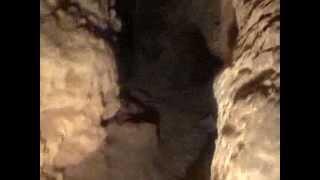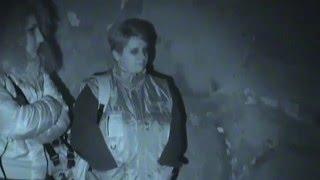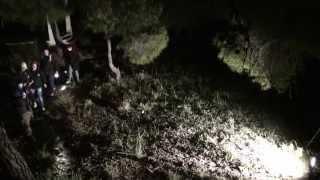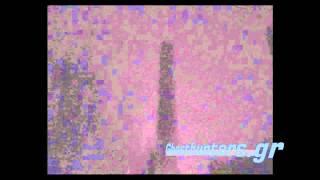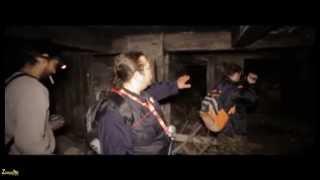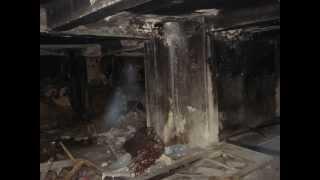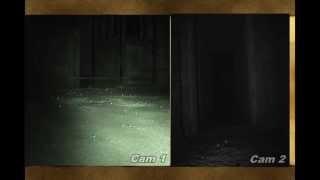00:15 - Eumycetoma (madura foot)
Is a chronic granulomatous fungal disease of humans, affecting mainly the limbs, and sometimes the abdominal and chest walls or the head. Mycetoma pedis (mycetoma of the foot), the most common form of mycetoma, is known widely as the Madura foot. The infection is endemic in Africa, India and the Central and South Americas.
01:36 - Noma
Noma disease also known as cancrum oris, is a rapidly progressive, microbial and gangrenous infection of the mouth or genitals. It is caused by bacterial organisms but is more common in those who are malnourished, practice poor hygiene, and have immunodeficiency diseases such as AIDS. Symptoms include the degeneration of tissues around mouth ulcers and eventually the degeneration of bones as well. This often results in the exposure of the sufferer’s mouth and teeth, creating windows into their mouths.
02:19 - Filarial Worms
Is a parasitic disease caused by an infection with roundworms of the Filarioidea type. These are spread by blood-feeding black flies and mosquitoes. This disease belongs to the group of diseases called helminthiases.
03:01 - Complex regional pain syndrome (CRPS)
Is a long term condition that often worsens with time. It is characterized by severe pain and sensitivity, swelling, and changes in the skin. It may initially affect one limb and then spread throughout the body; 35% of people affected report symptoms throughout their whole body.
03:49 - Vibrio Vulnificus
is a species of Gram-negative, motile, curved, rod-shaped (bacillus), pathogenic bacteria of the genus Vibrio. Present in marine environments such as estuaries, brackish ponds, or coastal areas, V. vulnificus is related to V. cholerae, the causative agent of cholera.
04:44 - Leprosy
Also known as Hansen's disease (HD), is a long-term infection by the bacteria Mycobacterium leprae or Mycobacterium lepromatosis. Initially, infections are without symptoms and typically remain this way for 5 to 20 years. Symptoms that develop include granulomas of the nerves, respiratory tract, skin, and eyes. This may result in a lack of ability to feel pain, thus loss of parts of extremities due to repeated injuries or infection due to unnoticed wounds. Weakness and poor eyesight may also be present.
06:11 - Fibrodysplasia Ossificans Progressiva (FOP)
Fibrodysplasia ossificans progressiva or (FOP) is an extremely rare disease affecting the connective tissue in the body. It causes the fibrous tissues (like muscles, tendons, and ligaments) to turn into bone spontaneously or when damaged. It is sometimes called stone man syndrome because it will slowly turn a person's body completely into bone, making them seem frozen in place like a statue.
07:12 - Elephant Man syndrome
Joseph Carey Merrick (5 August 1862 – 11 April 1890; often incorrectly called John Merrick) was an English man with very severe deformities who was first exhibited at a freak show as the "Elephant Man", and then went to live at the London Hospital after he met Frederick Treves, so becoming well known in London society. Merrick was born in Leicester, and began to develop abnormally during the first few years of his life: his skin appeared thick and lumpy, he developed enlarged lips, and a bony lump grew on his forehead, one of his arms and both of his feet became enlarged and at some point during his childhood he fell and damaged his hip, resulting in permanent lameness. When he was 9, his mother died from bronchopneumonia, and his father soon remarried. Merrick left school at the age of 13 and had difficulty finding employment. Rejected by his father and stepmother, he left home. In late 1879, Merrick, aged 17, entered the Leicester Union Workhouse.
08:39 - Epidermodysplasia verruciformis
Tree-Man Syndrome is an extremely rare hereditary skin disorder the resulting in uncontrolled HPV infections that result in scaly macules and papules and particularly on the hands and feet. The texture of these skin infections have been compared to bark. There is no known treatment for the proliferation of these bark-like rashes except for regular surgical removals of the growths.
09:10 - Limbal Dermoids
Limbal Dermoids are tumors of the eye that form on the limbus part of the cornea. It can cause vision problems but are otherwise benign and not cancerous. However, besides their painful appearance, they also grow actual hair. Out of your eyes.
09:40 - SUBSCRIBE -
Thanks for watching!
—————————————————————————————————————
FAIR USE NOTICE: This video may contain copyrighted material. Such material is made available for educational purposes only. This constitutes a 'fair use' of any such copyrighted material as provided for in Title 17 U.S.C. section 106A-117 of the U.S. Copyright Law. ⒻⓊ
Is a chronic granulomatous fungal disease of humans, affecting mainly the limbs, and sometimes the abdominal and chest walls or the head. Mycetoma pedis (mycetoma of the foot), the most common form of mycetoma, is known widely as the Madura foot. The infection is endemic in Africa, India and the Central and South Americas.
01:36 - Noma
Noma disease also known as cancrum oris, is a rapidly progressive, microbial and gangrenous infection of the mouth or genitals. It is caused by bacterial organisms but is more common in those who are malnourished, practice poor hygiene, and have immunodeficiency diseases such as AIDS. Symptoms include the degeneration of tissues around mouth ulcers and eventually the degeneration of bones as well. This often results in the exposure of the sufferer’s mouth and teeth, creating windows into their mouths.
02:19 - Filarial Worms
Is a parasitic disease caused by an infection with roundworms of the Filarioidea type. These are spread by blood-feeding black flies and mosquitoes. This disease belongs to the group of diseases called helminthiases.
03:01 - Complex regional pain syndrome (CRPS)
Is a long term condition that often worsens with time. It is characterized by severe pain and sensitivity, swelling, and changes in the skin. It may initially affect one limb and then spread throughout the body; 35% of people affected report symptoms throughout their whole body.
03:49 - Vibrio Vulnificus
is a species of Gram-negative, motile, curved, rod-shaped (bacillus), pathogenic bacteria of the genus Vibrio. Present in marine environments such as estuaries, brackish ponds, or coastal areas, V. vulnificus is related to V. cholerae, the causative agent of cholera.
04:44 - Leprosy
Also known as Hansen's disease (HD), is a long-term infection by the bacteria Mycobacterium leprae or Mycobacterium lepromatosis. Initially, infections are without symptoms and typically remain this way for 5 to 20 years. Symptoms that develop include granulomas of the nerves, respiratory tract, skin, and eyes. This may result in a lack of ability to feel pain, thus loss of parts of extremities due to repeated injuries or infection due to unnoticed wounds. Weakness and poor eyesight may also be present.
06:11 - Fibrodysplasia Ossificans Progressiva (FOP)
Fibrodysplasia ossificans progressiva or (FOP) is an extremely rare disease affecting the connective tissue in the body. It causes the fibrous tissues (like muscles, tendons, and ligaments) to turn into bone spontaneously or when damaged. It is sometimes called stone man syndrome because it will slowly turn a person's body completely into bone, making them seem frozen in place like a statue.
07:12 - Elephant Man syndrome
Joseph Carey Merrick (5 August 1862 – 11 April 1890; often incorrectly called John Merrick) was an English man with very severe deformities who was first exhibited at a freak show as the "Elephant Man", and then went to live at the London Hospital after he met Frederick Treves, so becoming well known in London society. Merrick was born in Leicester, and began to develop abnormally during the first few years of his life: his skin appeared thick and lumpy, he developed enlarged lips, and a bony lump grew on his forehead, one of his arms and both of his feet became enlarged and at some point during his childhood he fell and damaged his hip, resulting in permanent lameness. When he was 9, his mother died from bronchopneumonia, and his father soon remarried. Merrick left school at the age of 13 and had difficulty finding employment. Rejected by his father and stepmother, he left home. In late 1879, Merrick, aged 17, entered the Leicester Union Workhouse.
08:39 - Epidermodysplasia verruciformis
Tree-Man Syndrome is an extremely rare hereditary skin disorder the resulting in uncontrolled HPV infections that result in scaly macules and papules and particularly on the hands and feet. The texture of these skin infections have been compared to bark. There is no known treatment for the proliferation of these bark-like rashes except for regular surgical removals of the growths.
09:10 - Limbal Dermoids
Limbal Dermoids are tumors of the eye that form on the limbus part of the cornea. It can cause vision problems but are otherwise benign and not cancerous. However, besides their painful appearance, they also grow actual hair. Out of your eyes.
09:40 - SUBSCRIBE -
Thanks for watching!
—————————————————————————————————————
FAIR USE NOTICE: This video may contain copyrighted material. Such material is made available for educational purposes only. This constitutes a 'fair use' of any such copyrighted material as provided for in Title 17 U.S.C. section 106A-117 of the U.S. Copyright Law. ⒻⓊ
Sign in or sign up to post comments.
Be the first to comment





